厦门大学:《现代生物实验学》课程教学课件(PPT讲稿)LAB 3-7大分子物质的水解实验和IMVIC实验
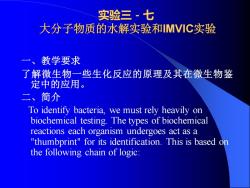
实验三-七 大分子物质的水解实验和IMVIC实验 一、教学要求 了解微生物一些生化反应的原理及其在微生物鉴 定中的应用。 二、简介 To identify bacteria, we must rely heavily on biochemical testing. The types of biochemical reactions each organism undergoes act as a "thumbprint" for its identification. This is based on the following chain of logic:
实验三-七 大分子物质的水解实验和IMVIC实验 一、教学要求 了解微生物一些生化反应的原理及其在微生物鉴 定中的应用。 二、简介 To identify bacteria, we must rely heavily on biochemical testing. The types of biochemical reactions each organism undergoes act as a "thumbprint" for its identification. This is based on the following chain of logic:

•Each different species of bacterium has a different molecule of DNA (i.e., DNA with a unique series of nucleotide bases). •Since DNA codes for protein synthesis, then different species of bacteria must, by way of their unique DNA, be able to synthesize different protein enzymes. •Enzymes catalyze all the various chemical reactions of which the organism is capable. This in turn means that different species of bacteria must carry out different and unique sets of biochemical reactions
•Each different species of bacterium has a different molecule of DNA (i.e., DNA with a unique series of nucleotide bases). •Since DNA codes for protein synthesis, then different species of bacteria must, by way of their unique DNA, be able to synthesize different protein enzymes. •Enzymes catalyze all the various chemical reactions of which the organism is capable. This in turn means that different species of bacteria must carry out different and unique sets of biochemical reactions
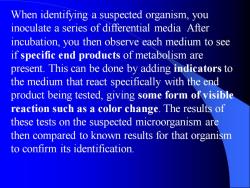
When identifying a suspected organism, you inoculate a series of differential media After incubation, you then observe each medium to see if specific end products of metabolism are present. This can be done by adding indicators to the medium that react specifically with the end product being tested, giving some form of visible reaction such as a color change. The results of these tests on the suspected microorganism are then compared to known results for that organism to confirm its identification
When identifying a suspected organism, you inoculate a series of differential media After incubation, you then observe each medium to see if specific end products of metabolism are present. This can be done by adding indicators to the medium that react specifically with the end product being tested, giving some form of visible reaction such as a color change. The results of these tests on the suspected microorganism are then compared to known results for that organism to confirm its identification

1、Macromolecules hydrolysis •Exoenzymes diastase(amylase)、protease、 lipase • endoenzymes • Starch hydrolysis Some bacteria are capable of using starch as a source of carbohydrate but in order to do this, they must first hydrolyze or break down the starch so it may enter the cell. The bacterium secretes an exoenzyme which hydrolyzes the starch by breaking the bonds between the glucose molecules. This enzyme is called a diastase (amylase)
1、Macromolecules hydrolysis •Exoenzymes diastase(amylase)、protease、 lipase • endoenzymes • Starch hydrolysis Some bacteria are capable of using starch as a source of carbohydrate but in order to do this, they must first hydrolyze or break down the starch so it may enter the cell. The bacterium secretes an exoenzyme which hydrolyzes the starch by breaking the bonds between the glucose molecules. This enzyme is called a diastase (amylase)
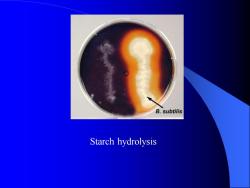
Starch hydrolysis
Starch hydrolysis

•protein hydrolysis Proteins are made up of various amino acids linked together in long chains by means of peptide bonds. Many bacteria can hydrolyze a variety of proteins into peptides (short chains of amino acids) and eventually into individual amino acids. They can then use these amino acids to synthesize their own proteins and other cellular molecules or to obtain energy. The hydrolysis of protein is termed proteolysis and the enzyme involved is called a protease
•protein hydrolysis Proteins are made up of various amino acids linked together in long chains by means of peptide bonds. Many bacteria can hydrolyze a variety of proteins into peptides (short chains of amino acids) and eventually into individual amino acids. They can then use these amino acids to synthesize their own proteins and other cellular molecules or to obtain energy. The hydrolysis of protein is termed proteolysis and the enzyme involved is called a protease
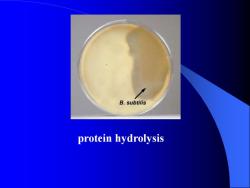
protein hydrolysis
protein hydrolysis
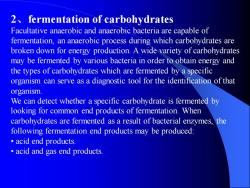
2、fermentation of carbohydrates Facultative anaerobic and anaerobic bacteria are capable of fermentation, an anaerobic process during which carbohydrates are broken down for energy production. A wide variety of carbohydrates may be fermented by various bacteria in order to obtain energy and the types of carbohydrates which are fermented by a specific organism can serve as a diagnostic tool for the identification of that organism. We can detect whether a specific carbohydrate is fermented by looking for common end products of fermentation. When carbohydrates are fermented as a result of bacterial enzymes, the following fermentation end products may be produced: • acid end products. • acid and gas end products
2、fermentation of carbohydrates Facultative anaerobic and anaerobic bacteria are capable of fermentation, an anaerobic process during which carbohydrates are broken down for energy production. A wide variety of carbohydrates may be fermented by various bacteria in order to obtain energy and the types of carbohydrates which are fermented by a specific organism can serve as a diagnostic tool for the identification of that organism. We can detect whether a specific carbohydrate is fermented by looking for common end products of fermentation. When carbohydrates are fermented as a result of bacterial enzymes, the following fermentation end products may be produced: • acid end products. • acid and gas end products
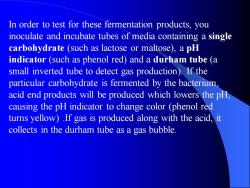
In order to test for these fermentation products, you inoculate and incubate tubes of media containing a single carbohydrate (such as lactose or maltose), a pH indicator (such as phenol red) and a durham tube (a small inverted tube to detect gas production). If the particular carbohydrate is fermented by the bacterium, acid end products will be produced which lowers the pH, causing the pH indicator to change color (phenol red turns yellow) .If gas is produced along with the acid, it collects in the durham tube as a gas bubble
In order to test for these fermentation products, you inoculate and incubate tubes of media containing a single carbohydrate (such as lactose or maltose), a pH indicator (such as phenol red) and a durham tube (a small inverted tube to detect gas production). If the particular carbohydrate is fermented by the bacterium, acid end products will be produced which lowers the pH, causing the pH indicator to change color (phenol red turns yellow) .If gas is produced along with the acid, it collects in the durham tube as a gas bubble
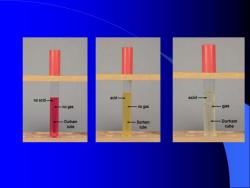
acid- acid- no acid- -no gas no gas -gas Durham Durham Durham tube tube tube
按次数下载不扣除下载券;
注册用户24小时内重复下载只扣除一次;
顺序:VIP每日次数-->可用次数-->下载券;
- 厦门大学:《现代生物实验学》课程教学课件(PPT讲稿)lab2-细菌的芽孢染色.ppt
- 厦门大学:《现代生物实验学》课程教学课件(PPT讲稿)lab1-细菌的革兰氏染色.ppt
- 厦门大学:《现代生物实验学》课程教学资源(教案讲义)5.9_植物叶片光合速率的测定.doc
- 厦门大学:《现代生物实验学》课程教学资源(教案讲义)5.8_植物生物学实验有关试剂配制.doc
- 厦门大学:《现代生物实验学》课程教学资源(教案讲义)5.7_遗传转化.doc
- 厦门大学:《现代生物实验学》课程教学资源(教案讲义)5.6_叶绿体色素的提取分离及理化性质.doc
- 厦门大学:《现代生物实验学》课程教学资源(教案讲义)5.5_显微绘图和低等植物的观察.doc
- 厦门大学:《现代生物实验学》课程教学资源(教案讲义)5.4_切花保鲜及采后生理.doc
- 厦门大学:《现代生物实验学》课程教学资源(教案讲义)5.3_颈卵器植物的观察.doc
- 厦门大学:《现代生物实验学》课程教学资源(教案讲义)5.2_环境样品的采集、处理与分析.doc
- 厦门大学:《现代生物实验学》课程教学资源(教案讲义)5.1_GUS基因检测.doc
- 厦门大学:《现代生物实验学》课程教学资源(教案讲义)5.11_组织培养实验.doc
- 厦门大学:《现代生物实验学》课程教学资源(教案讲义)5.10_植物制片技术及高等植物形态结构.doc
- 厦门大学:《现代生物实验学》课程教学资源(教案讲义)生物化学实验实验准备.doc
- 厦门大学:《现代生物实验学》课程教学课件(PPT讲稿)实验一、淀粉的提取和水解.ppt
- 厦门大学:《现代生物实验学》课程教学课件(PPT讲稿)Lab-3土壤中细菌总数的测定.ppt
- 厦门大学:《现代生物实验学》课程教学课件(PPT讲稿)Lab-2土壤细菌的分离与纯化.ppt
- 厦门大学:《现代生物实验学》课程教学课件(PPT讲稿)Lab-1培养基的配制与灭菌.ppt
- 厦门大学:《现代生物实验学》课程教学课件(PPT讲稿)实验十八、印相和放大.ppt
- 厦门大学:《现代生物实验学》课程教学课件(PPT讲稿)模块四 显微摄影与暗房技术.ppt
- 厦门大学:《现代生物实验学》课程教学课件(PPT讲稿)Lab-8细菌的快速测定.ppt
- 厦门大学:《现代生物实验学》课程教学课件(PPT讲稿)Lab-9霉菌的形态观察与鉴定.ppt
- 厦门大学:《现代生物实验学》课程教学课件(PPT讲稿)lab-1中和剂的选择.ppt
- 厦门大学:《现代生物实验学》课程教学课件(PPT讲稿)lab2-3 细菌芽孢悬液的制备和消毒剂杀菌效果的定量测定.ppt
- 厦门大学:《现代生物实验学》课程教学课件(PPT讲稿)lab-1放线菌的选择分离与计数.ppt
- 厦门大学:《现代生物实验学》课程教学课件(PPT讲稿)lab-2放线菌形态的观察.ppt
- 厦门大学:《现代生物实验学》课程教学课件(PPT讲稿)lab-3双层琼脂扩散法筛选抗菌活性菌株.ppt
- 厦门大学:《现代生物实验学》课程教学资源(教案讲义)三、微生物学与免疫学实验准备.doc
- 厦门大学:《现代生物实验学》课程教学课件(PPT讲稿)实验二、总糖和还原糖的测定.ppt
- 厦门大学:《现代生物实验学》课程教学课件(PPT讲稿)lab-1酵母的形态观察.ppt
- 厦门大学:《现代生物实验学》课程教学课件(PPT讲稿)lab-2-3酵母胞外多糖的液体发酵、胞外多糖的提取与测定.ppt
- 厦门大学:《现代生物实验学》课程教学课件(PPT讲稿)lab-1双向琼脂免疫扩散.ppt
- 厦门大学:《现代生物实验学》课程教学课件(PPT讲稿)lab-2单向琼脂免疫扩散.ppt
- 厦门大学:《现代生物实验学》课程教学课件(PPT讲稿)lab-3间接凝集反应检测血清类风湿因子.ppt
- 厦门大学:《现代生物实验学》课程教学课件(PPT讲稿)lab-4免疫电泳.ppt
- 厦门大学:《现代生物实验学》课程教学课件(PPT讲稿)lab-5小鼠腹腔巨噬细胞收集及形态观察.ppt
- 厦门大学:《现代生物实验学》课程教学课件(PPT讲稿)lab-6血清抗体的分离与纯化.ppt
- 厦门大学:《现代生物实验学》课程教学课件(PPT讲稿)lab-7辣根过氧化物酶标记抗体.ppt
- 厦门大学:《现代生物实验学》课程教学课件(PPT讲稿)lab-8酶联免疫吸附试验(ELISA).ppt
- 厦门大学:《现代生物实验学》课程教学资源(教案讲义)四、动物生物学实验准备.doc
